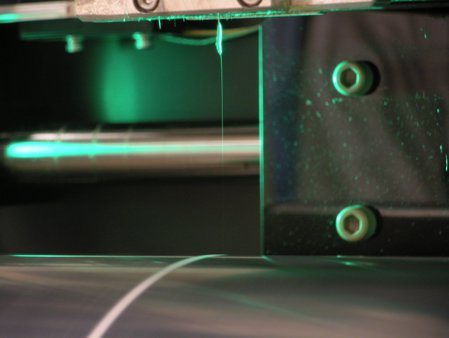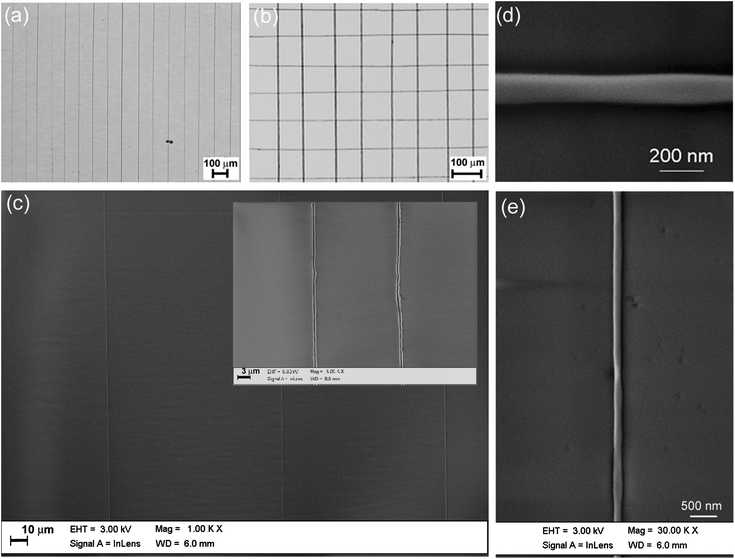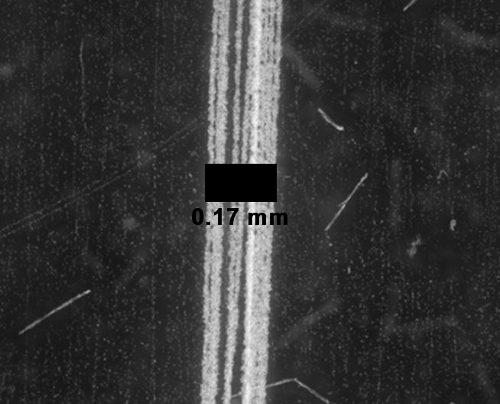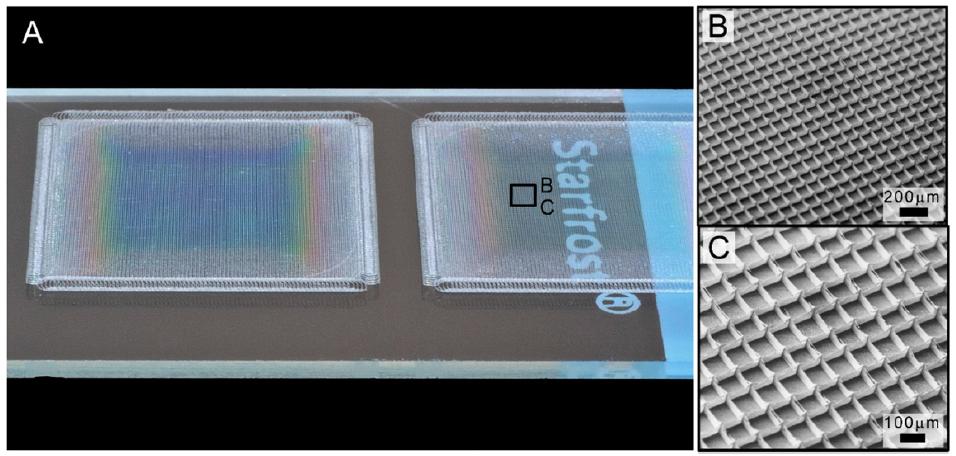▼ Reference
- Angammana C J. A Study of the Effects of Solution and Process Parameters on the Electrospinning Process and Nanofibre Morphology. University of Waterloo, Canada, PhD Thesis 2011. Open Access
- Arras M M L, Grasl C, Bergmeister H, Schima H (2012) Electrospinning of aligned fibers with adjustable orientation using auxiliary electrodes. Sci. Technol. Adv. Mater. 13, 035008. Open Access
- Baumgarten P K (1971) Electrostatic spinning of acrylic microfibers. Journal of Colloid and Interface Science 36 pp. 71
- Bisht G S, Canton G, Mirsepassi A, Kulinsky L, Oh S, Dunn-Rankin D, Madou M J. Controlled Continuous Patterning of Polymeric Nanofibers on Three-Dimensional Substrates Using Low-Voltage Near-Field Electrospinning. Nano Lett. 2011; 11: 1831.
- Brown T D, Edin F, Detta N, Skelton A D, Hutmacher D W, Dalton P D. Melt electrospinning of poly(ε-caprolactone) scaffolds: Phenomenological observations associated with collection and direct writing. Materials Science and Engineering C 2014 Ahead of print
- Camillo D D, Fasano V, Ruggieri F, Santucci S, Lozzi L, Camposeo A, Pisignano D. Near-field electrospinning of conjugated polymer light-emitting nanofibers. Nanoscale 2013; 5: 11637. Open Access
- Chang C, Limkrailassiri K, Lin L (2008) Continuous near-field electrospinning for large area deposition of orderly nanofiber patterns. Appl Phys Lett 93 pp.123111
- Chang J. Electrospun Direct-write Multi-functional Nanofibers. PhD Thesis 2012 University of Califonia, Berkeley. Open Access
- Christ H A, Ang P Y, Li F, Johannes H H, Kowalsky W, Menzel H. Production of highly aligned microfiber bundles from polymethyl methacrylate via stable jet electrospinning for organic solid-state lasers. Journal of Polymer Science 2022; 60: 715. Open Access
- Coppola S, Nasti G, Vespini V, Ferraro P. Layered 3D Printing by Tethered Pyro-Electrospinning. Advances in Polymer Technology 2020; 2020: 1252960. Open Access
- Dalton P D, Joergensen N T, Groll J, Moeller M (2008) Patterned melt electrospun substrates for tissue engineering Biomed. Mater. 3, 034109
- Deitzel J M, Kleinmeyer J D, Hirvonen J K, Tan N C B (2001) Controlled deposition of electrospun poly(ethylene oxide) fibers. Polymer 2001; 42: 8163
- Farrugia B, Brown T D, Upton Z, Hutmacher D W, Dalton P D, Dargaville T R. Dermal fibroblast infiltration of poly(ε-caprolactone) scaffolds fabricated by melt electrospinning in a direct writing mode. Biofabrication 2013; 5: 025001.
- Feng Z Q, Wu J, Cho W, Leach M K, Franz E W, Naim Y I, Gu Z Z, Corey J M, Martin D C. Highly aligned poly(3,4-ethylene dioxythiophene) (PEDOT) nano- and microscale fibers and tubes. Polymer 2013; 54: 702.
- Fuh Y K, Chen S Z, He Z Y. Direct-write, highly aligned chitosan-poly(ethylene oxide) nanofiber patterns for cell morphology and spreading control. Nanoscale Research Letters 2013; 8: 97. Open Access
- Gupta A, Seifalian M, Ahmad Z, Edirisinghe M J and Winslet M C (2007) Novel electrohydrodynamic printing of nanocomposite biopolymer scaffolds. J. Bioact. Compat. Polym. 22 pp. 265
- He JH, Wu Y, Zuo WW. Critical length of straight jet in electrospinning. Polymer 2005 46: p. 12637-12640.
- Hellmann C, Belardi K, Dersch R, Greiner A, Wendorff J H, Bahnmueller S (2009) High Precision Deposition Electrospinning of nanofibers and nanofiber nonwovens. Polymer 50 pp. 1197
- Hochleitner G, Jungst T, Brown T D, Hahn K, Moseke C, Jakob F, Dalton P D, Groll J. Additive manufacturing of scaffolds with sub-micron filaments via melt electrospinning writing. Biofabrication 2015; 7: 035002. Open Access
- Hochleitner G, Youssef A, Hrynevich A, Haigh J N, Jungst T, Groll J, Dalton P D. Fibre pulsing during melt electrospinning writing. BioNanoMaterials 2016 Article in print. Open Access
- Hohman M M, Shin M, Rutledge G, Brenner M P. Electrospinning and electrically forced jets. II. Applications. Physics of Fluids 2001; 13: 2221. Open Access
- Huang Y A, Duan Y, Ding Y, Bu N, Pan Y, Lu N, Yin Z. Versatile, kinetically controlled, high precision electrohydrodynamic writing of micro/nanofibers. Science Reports 2014; 4: 5949. Open Access
- Jeong Y H, Lee J. Fabrication of Microfiber Patterns with Ivy Shoot-Like Geometries Using Improved Electrospinning. Materials 2016; 9: 266. Open Access
- Jin Y, Gao Q, Xie C, Li G, Du J, Fu J, He Y. Fabrication of heterogeneous scaffolds using melt electrospinning writing: Design and optimization. Materials & Design 2020; 185: 108274. Open Access
- Kameoka J, Craighead H G (2003) Fabrication of oriented polymeric nanofibers on planar surfaces by electrospinning Appl. Phys. Lett. 83 pp. 371
- Kiselev P, Rosell-Llompart J. Highly Aligned Electrospun Nanofibers by Elimination of the Whipping Motion. J Appl Polym Sci 2012; 125: 2433
- Korkut S, Saville D A, Aksay I A. Enhanced Stability of Electrohydrodynamic Jets through Gas Ionization. Physical Review Letters 2008; 100: 034503.
- Kowalewski T A, Blonski S, Barral S (2005) Experiments and modelling of electrospinning process. Bull. Polym. Acad. Sci.: Tech. Sci. 53 pp. 385. Open Access
- Milleret V, Simona B, Neuenschwander P, Hall H. Tuning Electrospinning Parameters for Production of 3D-Fiber Fleeces with Increased Porosity for Soft Tissue Engineering Applications. European Cells and Materials 2011; 21: 286. Open Access
- Min S Y, Kim T S, Kim B J, Cho H C, Noh Y Y, Yang H C, Cho J H, Lee T W. Large-scale organic nanowire lithography and electronics. Nature Communications 2013; 4: 1773.
- Moon S, Jones M S, Seo E, Lee J, Lahann L, Jordahl J H, Lee K J, Lahann J. 3D jet writing of mechanically actuated tandem scaffolds. Science Advances 2021; 7 Open Access
- Ou K L, Lu J C, Shu Y C, Tseng W C, Yang J C, Lee S Y, Chen C C. Membranes of Epitaxial-like Packed, Super Aligned Electrospun Micron Hollow Poly(L-lactic acid) (PLLA) Fibers. European Polymer Journal (2011) doi: 10.1016/j.eurpolymj.2011.02.001
- Qin X, Lin J, Lu W, Shou D, Fan J. Stretching of the steady jet in electrospinning: theoretical analysis and experimental verification. Textile Research Journal 2010; 81: 388-397
- Reneker D H, Kataphinan W, Theron A, Zussman E, Yarin A L (2002) Nanofiber garlands of polycaprolactone by electrospinning. Polymer 43 pp. 6785.
- Reneker D H, Yarin A L, Fong H, Koombhongse S. Bending instability of electrically charged liquid jets of polymer solutions in electrospinning. J Appl Phys. 2000; 87: 4531.
- Shin Y M, Hohman M M, Brenner M P, Rutledge G C. Experimental characterization of electrospinning: the electrically forced jet and instabilities. Polymer 2001; 42: 9955.
- Song C, Rogers J A, Kim J M, Ahn H. Patterned Polydiacetylene-Embedded Polystyrene Nanofibers Based on Electrohydrodynamic Jet Printing. Macromolecular Research 2015; 23: 118.
- Sugimoto R, Lee J H, Lee J H, Jin H E, Yoo S Y, Lee S W. Bacteriophage nanofiber fabrication using near field electrospinning. RSC Adv. 2019; 9: 39111. Open Access
- Sun D, Chang C, Li S, Lin L (2006) Near-field electrospinning Nano Lett. 6 pp. 839
- Sun Z, Deitzel J M, Knopf J, Chen X, Gillespie Jr. J W. The Effect of Solvent Dielectric Properties on the Collection of Oriented Electrospun Fibers. J. Appl. Polym. Sci. 2012; 125: 2585.
- Thompson C J, Chase G G, Yarin A L, Reneker D H. Effects of parameters on nanofiber diameter determined from electrospinning model. Polymer 2007; 48: 6913.
- Wang C, Chien H S, Yan K W, Hung C L, Hung K L, Tsai S J, Jhang H J. Correlation between processing parameters and microstructure of electrospun poly(D,L-lactic acid) nanofibers. Polymer 2009; 50: 6100.
- Wu C M, Chiou H G, Lin S L, Lin J M. Effects of Electrostatic Polarity and the Types of Electrical Charging on Electrospinning Behavior. J Appl Polym Sci 2012; 126: E89.
- Wu Y K, Wang L, Fan J, Shou W, Zhou B M, Liu Y. Multi-Jet Electrospinning with Auxiliary Electrode: The Influence of Solution Properties. Polymers 2018; 10(6): 572. Open Access
- Wu Y, Carnell L A, Clark R L. Control of electrospun mat width through the use of parallel auxiliary electrodes. Polymer 2007; 48: 5653.
- Xue N, Li X, Bertulli C, Li Z, Patharagulpong A, Sadok A, Huang Y Y S. Rapid Patterning of 1-D Collagenous Topography as an ECM Protein Fibril Platform for Image Cytometry. PLoS ONE 9(4): e93590. doi:10.1371/journal.pone.0093590. Open Access
- Yalcinkaya B, Yener F, Jirsak O, Cengiz-Callioglu F. On the Nature of Electric Current in the Electrospinning Process. Journal of Nanomaterials 2013; 2013: 538179 (10 pages). Open Access
- Yan F, Chen H, Zheng L, Chen W, Liu Y, Hu Q. The Controllable PVA-Chitosan Fiber Prepared by the Near-field Electro Spinning for Tissue Engineering. Advanced Journal of Food Science and Technology 2013; 5: 1073.
- Yang Y, Jia Z, Liu J, Li Q, Hou L, Wang L, Guan Z. (2008) Effect of electric field distribution uniformity on electrospinning. J. Appl. Phys. 103, 104307.
- Yuan H, Zhao S, Tu H, Li B, Li Q, Feng B, Peng H, Zhang Y (2012) Stable jet electrospinning for easy fabrication of aligned ultrafine fibers. J. Mater. Chem., 22, pp. 19634
- Yuan H, Zhou Q, Li B, Bao M, Lou X, Zhang Y. Direct printing of patterned three-dimensional ultrafine fibrous scaffolds by stable jet electrospinning for cellular ingrowth. Biofabrication 2015; 7: 045004.
- Zheng G, Li W, Wang X, Wu D, Sun D, Lin L. Precision deposition of a nanofibre by near-field electrospinning. J. Phys. D: Appl. Phys. 2010; 43: 415501.
- Zheng J Y, Liu H Y, Wang X, Zhao Y, Huang W W, Zheng G F, Sun D H. Electrohydrodynamic Direct-Write Orderly Micro/Nanofibrous Structure on Flexible Insulating Substrate. Journal of Nanomaterials 2014; 708186 (7 pages) Open Access
- Zhou Q, Bao M, Yuan H, Zhao S, Dong W, Zhang Y. Implication of stable jet length in electrospinning for collecting well-aligned ultrafine PLLA fibers. Polymer 2013; 54: 6867.
▼ Credit and Acknowledgement
Author
Wee-Eong TEO View profile
Email: weeeong@yahoo.com
 ElectrospinTech
ElectrospinTech









